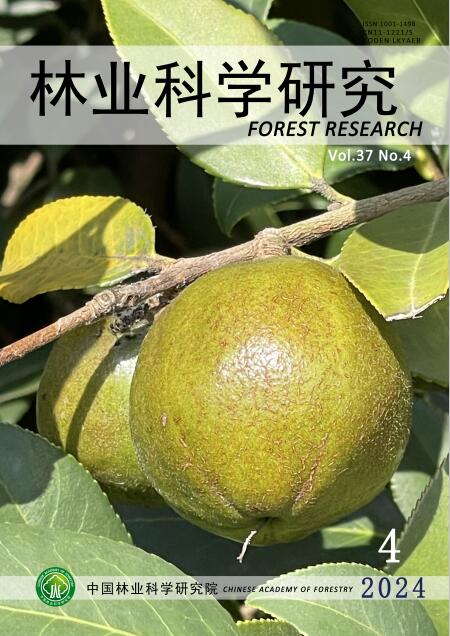Evaluation of Five East Texas Forages under Differing Shade Levels
Q4 Agricultural and Biological Sciences
引用次数: 0
Abstract
A pot study was conducted to measure the establishment success of five forages under 0%, 30% or 60% shade levels. The forages evaluated were ‘Pensacola” Bahia grass (Paspalum notatum Fluegge), “Texas Tough” Bermuda grass (Cynodon dactylon L. Pers.), “Alamo” switch grass (Panicum virgatum L.), “San Marcos” Eastern Gama grass (Tripsacum dactyloides L.), and a native mix containing by weight 45% “Texas” little bluestem (Schizachyrium scoparium Michx Nash), 15% sand love grass (Eragrostis trichodes Nutt. L. Alph. Wood), 15% “Blackwell” switch grass (Panicum virgatum L.), 10% “Lometa” Indian grass (Sorgastrum nutans L. Nash), 10% “Haskell” sideoats grama (Bouteloua curtipendula Michx Torr) and 5% “Earl” big bluestem (Andropgon gerardii Vitman). Mean biomass under 60% shades for all forages was less than under the other shade treatments, but did not differ among shade treatments within forages. Mean nutrient tissue concentration showed significant differences among treatments and forages for several nutrients. Shade treatments had no effect on plant density, but low germination of several forages appears to have influenced plant density. Based on these results, Bahia grass, eastern Gama grass and Bermuda grass may be suitable species if maximum biomass production were the goal of a silvopasture management system in east Texas.不同遮荫水平下5种东德克萨斯牧草的评价
通过盆栽试验,测定了5种牧草在0%、30%和60%遮荫条件下的成活率。评价的牧草为“Pensacola”巴伊亚草(Paspalum notatum Fluegge)、“Texas Tough”百慕大草(Cynodon dactylon L. Pers.)、“Alamo”柳条草(Panicum virgatum L.)、“San Marcos”east Gama草(Tripsacum dactyloides L.),以及含有45%重量的“Texas”小蓝茎(Schizachyrium scoparium Michx Nash)、15%重量的沙爱草(Eragrostis trichodes Nutt)的本地混合物。l . Alph。木材),15%的“Blackwell”柳枝草(Panicum virgatum L.), 10%的“Lometa”印度草(Sorgastrum nutans L. Nash), 10%的“Haskell”侧边草(Bouteloua curtipendula Michx Torr)和5%的“Earl”大蓝茎(Andropgon gerardii Vitman)。60%遮荫下所有牧草的平均生物量均低于其他遮荫处理,但不同遮荫处理之间的生物量差异不大。几种营养物质的平均组织浓度在不同处理和不同饲料之间存在显著差异。遮荫处理对植物密度没有影响,但几种牧草的低发芽率似乎对植物密度有影响。基于这些结果,如果以最大生物量生产为目标,那么巴伊亚草、东伽马草和百慕大草可能是适宜的物种。
本文章由计算机程序翻译,如有差异,请以英文原文为准。
求助全文
约1分钟内获得全文
求助全文
来源期刊

林业科学研究
Environmental Science-Ecology
CiteScore
0.90
自引率
0.00%
发文量
4834
期刊介绍:
Forestry Research is a comprehensive academic journal of forestry science organized by the Chinese Academy of Forestry. The main task is to reflect the latest research results, academic papers and research reports, scientific and technological developments and information on forestry science mainly organized by the Chinese Academy of Forestry, to promote academic exchanges at home and abroad, to carry out academic discussions, to flourish forestry science, and to better serve China's forestry construction.
The main contents are: forest seeds, seedling afforestation, forest plants, forest genetic breeding, tree physiology and biochemistry, forest insects, resource insects, forest pathology, forest microorganisms, forest birds and animals, forest soil, forest ecology, forest management, forest manager, forestry remote sensing, forestry biotechnology and other new technologies, new methods, and to increase the development strategy of forestry, the trend of development of disciplines, technology policies and strategies, etc., and to increase the forestry development strategy, the trend of development of disciplines, technology policies and strategies. It is suitable for scientists and technicians of forestry and related disciplines, teachers and students of colleges and universities, leaders and managers, and grassroots forestry workers.
 求助内容:
求助内容: 应助结果提醒方式:
应助结果提醒方式:


